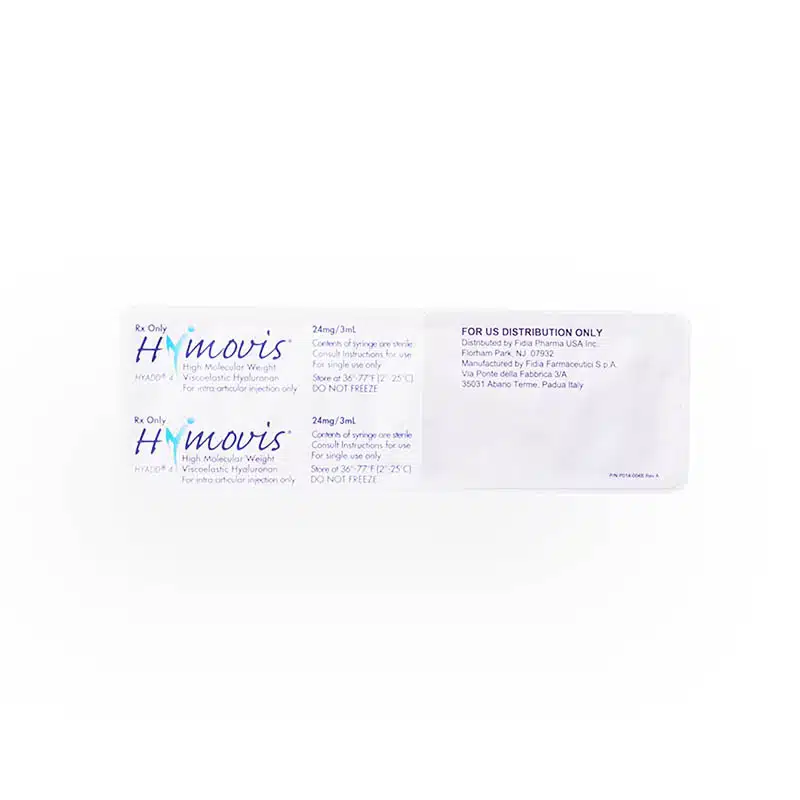Joint injections can often come with side effects, like temporary pain and swelling, and in some cases, more serious problems like cartilage damage or joint infections. Over time, repeated injections can raise the risk of complications, which is why doctors usually recommend limiting how often they’re given.
Hymovis, a type of hyaluronic acid injection, is used to treat knee osteoarthritis. Unlike cortisone shots, which mainly reduce inflammation, Hymovis helps lubricate the joint and can offer longer-lasting relief. But, like any treatment, it’s important to understand the potential side effects before deciding if it’s right for you.
In this article, we’ll dive into a list of Hymovis side effects, giving you all the information you need to make an informed choice about your treatment.
Key Takeaways
- Pain, swelling, or stiffness at the injection site are frequent reactions to Hymovis. These side effects often occur immediately after the procedure but typically subside over time.
- Fluid buildup in the joint can lead to tightness and reduced mobility, which some patients may experience post-injection.
- Allergic reactions (such as hives, itching, and breathing difficulties) are uncommon but can be severe.
- Joint infections and severe inflammation are rare but require immediate medical attention if they occur.
- Proper injection techniques and thorough skin preparation can reduce the risk of common side effects.
- Close monitoring and follow-up care after the injection can help identify and manage adverse reactions early.
- Always consult healthcare providers regarding potential side effects and preventive measures before undergoing Hymovis treatment.
About: Medical Spa RX provides medical practices with premium products at the best prices. If you’re looking to buy Hymovis for your practice, the sales representatives at Medical Spa RX can give you guidance.
Common Side Effects of Hymovis
- Localized Pain at the Injection Site: This reaction is normal and happens because the needle is inserted directly into the joint. Most people notice the discomfort right after the Hymovis treatment, but it usually doesn’t last long and tends to ease up within a few days.
- Swelling or Fluid Buildup in the Joint: Swelling or fluid buildup in the joint is a common side effect of Hymovis knee injections. It might make the joint feel tight and stiff when moving. Patients often see this after getting their treatment. While this can be uncomfortable, it usually goes away on its own after a few days to a week.
- Stiffness or Limited Range of Motion in the Joint: It can be frustrating if you can’t move your knee as freely as before, but the good news is that this stiffness usually fades with time. Many people find that the overall relief from knee pain makes it worth it once the initial stiffness is gone.
Rare Side Effects of Hymovis
- Allergic Reactions such as Hives, Itching, or Difficulty Breathing: These reactions from Hymovis can manifest as hives, itching, or, in more serious cases, difficulty breathing. They don’t happen often, but if they do, it’s important to seek medical attention right away.
- Joint Infections: An infection can happen if bacteria enter the joint during the procedure, leading to severe pain, swelling, or even redness in the knee. If you experience these symptoms, contacting your doctor immediately is crucial, as joint infections require prompt treatment.
- Severe Joint Pain or Inflammation: While some mild discomfort is expected after any injection, severe joint pain or inflammation is a much rarer side effect. If the pain seems extreme or doesn’t go away after a few days, it could signal something more serious, and you should let your healthcare provider know.
Minimizing the Risk of Hymovis Side Effects
To reduce the chances of side effects with Hymovis, both the technique used during the injection and the care you receive afterward play a big role.
First, it’s important that the injection is given properly. Doctors use sterile methods to prevent infections and ensure the injection goes directly into the knee joint. Some even use ultrasound to guide the needle to the right spot, which helps lower the risk of complications like pain or swelling after the procedure. This careful attention to technique helps keep side effects to a minimum.
But it doesn’t stop there—monitoring and follow-up care are just as important. After receiving the injection, your doctor will likely schedule check-ins to ensure you’re healing well and not experiencing any unexpected issues.
If something doesn’t feel right, like severe pain or swelling that won’t go away, it’s important to reach out right away. Keeping an open line of communication with your healthcare provider ensures that any side effects can be addressed early, which helps prevent them from getting worse.
By combining expert technique with attentive follow-up care, doctors can help you get the most out of Hymovis while minimizing the risks.
Conclusion
While Hymovis can cause some side effects, such as pain or swelling at the injection site, and in rare cases, allergic reactions or more serious complications, understanding how to minimize these risks can make a big difference.
If you have any concerns or questions about Hymovis, don’t hesitate to reach out to your healthcare provider. They can offer guidance and help ensure your treatment is as safe and effective as possible.
FAQs
1. What is Hymovis used for?
Hymovis is a hyaluronic acid injection primarily used to treat knee osteoarthritis by providing lubrication to the joint, which helps reduce pain and improve mobility.
2. Is Hymovis a one-time treatment?
Hymovis can be part of a treatment plan that may require multiple injections over time. Your doctor will determine the best schedule based on your individual condition.
3. How long do the side effects of Hymovis last?
Most common side effects, such as pain or swelling at the injection site, tend to be temporary and usually subside within a few days to a week.
4. Can I prevent side effects from Hymovis?
While side effects can’t be completely prevented, proper injection techniques by a trained healthcare professional and diligent follow-up care can significantly minimize risks.
References
Crockett, Z., Asikhia, O., Rhim, H., & others. (2024). Injection-based therapies for knee osteoarthritis: A comprehensive update. Current Physical Medicine and Rehabilitation Reports, 12(4), 256–265. https://doi.org/10.1007/s40141-024-00458-2
Eske J. Everything you need to know about hyaluronic acid. Published June 26, 2023. https://www.medicalnewstoday.com/articles/326385
Migliore, A., Frediani, B., Gigliucci, G., Foti, C., Crimaldi, S., De Lucia, O., & Iolascon, G. (2020). Efficacy of a Single Intra-Articular HYMOVIS ONE Injection for Managing Symptomatic Hip Osteoarthritis: A 12-Month Follow-Up Retrospective Analysis of the ANTIAGE Register Data. Orthopedic research and reviews, 12, 19–26. https://doi.org/10.2147/ORR.S239355





















